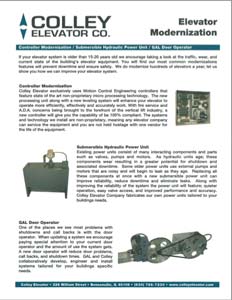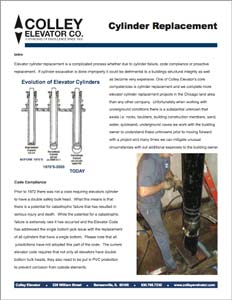The hydraulic elevator was invented in 1882 with steamed power, the steam power hydraulic elevator was replaced with oil and the hydraulic system was simplified which is how hydraulic elevators work today.
Description of hydraulic elevators
A hydraulic elevator uses a pump, motor and valve to push oil through cylinder(s) & piston(s) to move the elevator up and down. Please find a brochure of the main components
Click The Thumbnail To Open Our Modernation Brochure in PDF Format(510kb)
Types of hydraulic elevators
Conventional hydraulic elevator use an underground cylinder, are quite common for low level buildings with 2–5 floors (sometimes but seldom up to 6–8 floors), and have speeds of up to 200 feet/minute (1 meter/second).
Holeless hydraulic elevators were developed in the 1970 and use above ground cylinders, this was a practical change in design that was considered cost sensitive and seen as environmentally friendly for buildings with 2, 3, or 4 floors.
Roped hydraulic elevators use both above ground cylinders and a rope system, allowing the elevator to travel further than the piston has to move as it utilizes wire ropes in conjunction with two hydraulic jacks to lift the car at a 1:2 ratio as great as 100 feet.
Operation of hydraulic elevators
The low mechanical complexity of hydraulic elevators in comparison to traction elevators makes them ideal for low rise, low traffic installations. They are less energy efficient as the pump works against gravity to push the car and its passengers upwards; this energy is lost when the car descends on its own weight. The high current draw of the pump when starting up also places higher demands on a building’s electrical system.
Cylinder replacement
Elevator cylinder replacements are completed due to cylinder failure or mandatory requirements by a municipality. Prior to 1972 the elevator code did not acknowledge the necessity of a safety bulk head so many elevators may have been installed without a safety bulk head. If an elevator is not installed with a safety bulk head [two bottoms] there is a potential for catastrophic failure which can cause injury or death. For more information on cylinder replacement please click on our cylinder information brochure.
Click The Thumbnail To Open Our Cylinder Replacement Brochure in PDF Format(2800kb)
If building owners are interested in having Colley Elevator complete the elevator modernization please call 630-766-7230, email sales@colleyelevator or fill out our contact form.



